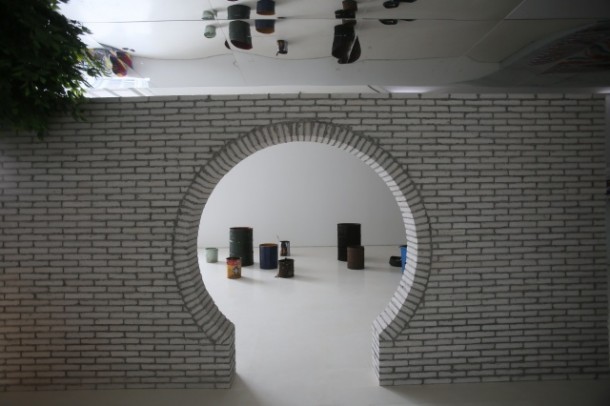YOU CAN ONLY THINK ABOUT SOMETHING IF YOU THINK OF SOMETHING ELSE
| November 14, 2014 | Post In LEAP 29
GUANGDONG TIMES MUSEUM
2014.08.23~2014.10.26
Times Museum projects are often accompanied by discussions about localization. This project was first disputed two years ago, when curators tried to question the definition of an art museum through the exhibition “A Museum That is Not,” particularly around the notion of a community art museum. How can a museum dropped into a community build relationships with it? As curators ask how to bring the mission of localization into the structure of the museum (a question raised in the exhibition and in its management), their very discourse can be perceived as elitist by the community they purport to serve. Discussions like the one surrounding “A Museum That is Not”—those concerning a museum or organization—quickly become metaphysical experiments, both with regard to the local community and in the Chinese art world as a whole. By contrast, “You Can Only Think About Something if You Think of Something Else” speaks on a more pressing issue: the potentially heterotopic relationship between art and the everyday.

Architectural intervention, installation view
The second installment of the “Times Heterotopia Trilogy,” this exhibition builds on Foucault’s notion of heterotopia, in which an actual space can heterogeneously approximate but never fully realize the status of utopia. The exhibition started at the studio of O-office Architects, who planned how to best integrate the project into the museum; to do so, the group has incorporated abstractions of nearby streets directly into the exhibition galleries. As soon as viewers enter, they face a mock food cart, a stone arch, a reflective steel path bolted to the ceiling, and an inverted fake tree hanging upside-down. This juxtaposition of what is “real” against what is “exhibited” defines the discourse of the show, an architectural intervention that adds structure to the classic white cube gallery space and, in doing so, holds the works included to a harsher standard, displaying pieces in a way that forces them to respond to the topic at hand. Of course, most visitors are not actively aware of the intentionality of this layout; they are more drawn to the game-based works included, like Li Liao’s Deadlock, in which five top-level gamers sit at computers with headphones on, completely absorbed in a game of “League of Legends” and only intermittently talking amongst themselves. Behind them, badge-wearing staff supervise the scene. Li creates new rules for the game: his players are not allowed to attack, but rather must remain on the defensive until their opponent forfeits. In a related installation, Turkish artist Ahmet Öğüt’s River Crossing Puzzle, visitors arrange life-size game pieces of a pet dog, solider, canine unit, wife, and daughter according to a set of guidelines in order to solve a puzzle.
The few commissioned pieces made specifically for the exhibition respond to its curatorial discourse to varying degrees. Li Jinghu, who makes an exception to his policy of not making pieces for specific organizations or opportunities, installs Cobweb in the corner of the space. Yu Ji’s Can the Ocean Horizon [Rise] Higher Than a Mountain, on the other hand, produces a triangular sloping barrier in the space. Flanked by Zhang Xinjun’s The Room Next to Anus, this unstable barrier makes it feel as if the museum has built its own little amusement park. Perhaps the piece most worth mentioning is the curators’ recreation of Tehching Hsieh’s One Year Performance 1980-1981. Near the entrance of the museum, visitors can enter their own punch card in a time clock in order to experience the process of Hsieh’s classic piece. Perhaps unbeknownst to the artist (and certainly apart from his original intent), One Year Performance is transformed into an activity of the everyday. It is here that the fundamental questions—the position of power between artist and curator, and the definition of an exhibition—once again emerge.

